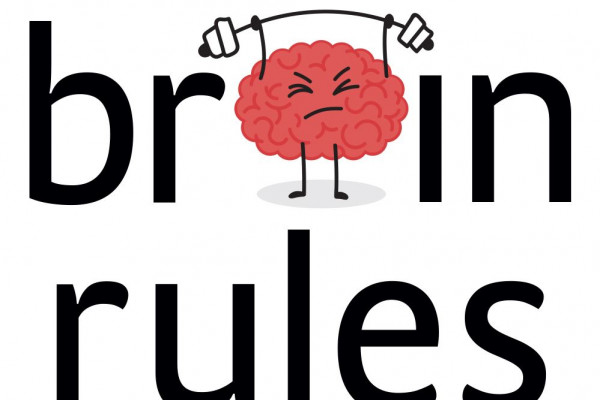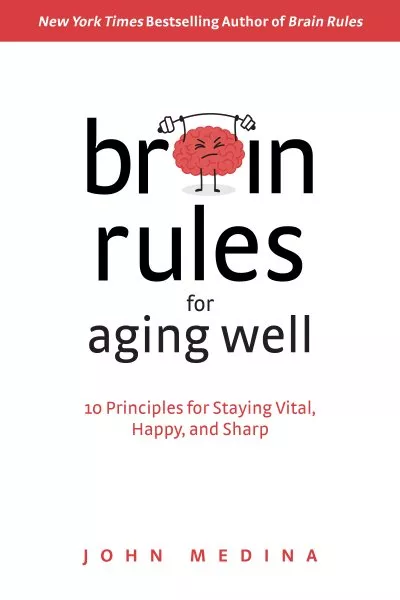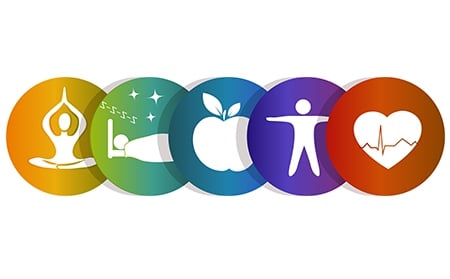Lively—almost childlike—the 70-year-old men skipped out of a monastery one fine morning. They’d just spent five days living in the old building, under observation by Harvard researcher Ellen Langer. Now the men were leaving for home—smiling, happy, active, laughing. It was the fall of 1981, the first year of Ronald Reagan’s administration, and the men had the same sunny abandonment associated with our 40th president—who, coincidentally, was exactly their age.

BRAIN RULE #1 - EXERCISE
But these seniors, as part of Langer’s research project, had just been through a time warp. Their brains had spent the past workweek not in 1981, but in 1959. The monastery was filled with songs like “Mac the Knife” and the “Battle of New Orleans.” On the black-and-white TV, the Boston Celtics beat the Minneapolis Lakers in the finals (yes, Minneapolis Lakers) and Johnny Unitas played for the Baltimore Colts. Issues of Life magazine and the Saturday Evening Post lay about. Ruth Handler had earlier in the year persuaded Mattel to create a thin, full-figured doll named after Ruth’s daughter, Barbie, and then market it to little girls who had yet to undergo puberty. President Eisenhower had just signed into law the Hawaii Admission Act, creating the 50th state.
That walk down memory lane was the reason the men were so happy as they left the monastery. Waiting for the bus to take them home, a few entered into a spontaneous game of touch football—an activity most had not done for decades.
You might not have recognized these men 120 hours previously. They were shuffling, with poor vision, hearing, and memory; some of the men required canes to walk into the monastery. A few could not carry their suitcases up to their rooms. Langer and her team had poked and prodded the men’s bodies, and assessed their brains. These baselines proved one thing: before entering the monastery, the men were stereotypically old, as if ordered from Central Casting under the request “Eight infirm seniors, please.”
But they didn’t stay infirm. At the end of their stay, they underwent the same tests. Reading about the quantifiable change took my breath away. Even a casual visual inspection of these seniors revealed that something dramatic had happened, as the New York Times reported. Their posture was more robust. Their hands gripped more tightly. They handled objects with greater dexterity. They moved more easily (touch football, for heaven’s sake!). Their hearing sharpened. Same with their vision. Yes, vision. A sampling of their conversation would have told you something in their brains had dramatically improved too, and this impression would be proved by a second round of IQ and memory tests. In honour of its extraordinary finding, the experiment has been christened the “counterclockwise study.”
Most advertising professionals, pop culture gurus, and historians understand the unstoppable power of “the good old days.” Yet they might be surprised to know that solid brain science says they’re doing us a favour: nostalgic experiences have many cognitive benefits.
Social psychologists such as Constantine Sedikdes and Tim Wildschut of the University of Southampton in the United Kingdom have broadened the field’s understanding of how rose-coloured memories of the past affect the less-rosy experiences of the present.
Sedikdes and Wildschut define nostalgia the same way the 1998 Oxford English Dictionary did: “a sentimental longing or wistful affection for the past”. But they don’t measure it as English majors would. They developed a psychometric test called the Southampton Nostalgia Scale to assess how much nostalgia a person is experiencing at any given time, and a research instrument – the event reflection task – powerful enough to induce nostalgia experimentally.
Nostalgia is often characterized as a form of cognitive quicksand. Wallow too much in it and a person can get stuck in the past. (The word “nostalgia” literally means “homecoming pain”, because it was thought that the physical and mental problems experienced by medieval soldiers came from a “toxic” longing to return home).
So what the researchers found was unexpected: nostalgia is actually good for you. We now know that people who regularly experience nostalgic stimuli are psychologically healthier than those who don’t. And we even know why, both at the behavioral levels and, astonishingly, at the cellular and molecular levels too.
Nostalgia promotes something called self-continuity, linking who you were in the past with who you are now (in technical terms, a form of temporal self-stability in which autobiographical memory traces are integrated with present-day experiences). People who regularly experience the benefits of nostalgia are less afraid of dying. Long-term partners become emotionally closer when reminiscing about shared memories. People become more generous to strangers after spending quality time in their “nostalgia zones”. They also become more tolerant of outsiders, especially ones with perceived social differences. Even sensory information gets into the act. People placed in a cold room who begin experiencing nostalgia start feeling warmer, even though no one turned the up the temperature.

When researchers look in the brain via non-invasive imaging, they discover how—and why—nostalgia works its behavioral alchemy.
As people reminisce, certain memory systems kick into overdrive, mostly involving the hippocampus. That result is not surprising; the hippocampus is involved in most of the brain’s memory systems. But more than memory is activated with nostalgia. Researchers discovered that regions like the substantia nigra light up like the Fourth of July during nostalgic experiences. So, too, does the ventral tegmental area. Both regions are involved in generating feelings of reward, and both use the neurotransmitter dopamine to make it happen.
This stimulation pattern has two interesting implications. First, your brain gives you a reward when you reminisce, so you want to repeat it. Second, reminiscing activates a neurotransmitter that is involved in learning and motor function - not just reward - and is, unhelpfully, fading with age.
All of a sudden we have a clue to the inner mainsprings of Langer’s Counterclockwise experiment. In it, waxing nostalgic didn’t just affect the participants’ attitudes, it also affected their bodies. Recall that the test subjects’ eyesight improved. They played touch football. Since dopamine affects not only brains but also motor function (destruction of the substantia nigra results in Parkinson’s, after all), it appears that the stimulation of dopamine in specific areas of the brain is the mechanism behind this positivity. That’s what nostalgia is good at, and since most senior brains exist in a critical dopamine drought, we now have very good news. Dopamine is an extremely useful neurotransmitter to keep around, for both body and brain.
So what do seniors wax most nostalgic for? The answer is embedded in reminiscence bumps. The phenomenon requires looking at the gross domestic product of memory output over a lifetime of experience. If you ask a group of eightysomethings what items or events or experiences they remember the most, you quickly find two things: (1) retrieval is not an even experience and (2) you get the exact same retrieval response curve. The graph looks like an unfinished drawing of a double-humped camel. It’s measuring a retrieval system that involves autobiographical memory.
This camel graph starts at zero and stays there for a bit, since nobody remembers much before the age of two or three. Retrieval climbs very quickly however, reaching its peak by age twenty. That peak comprises the top of the first hump. Retrieval starts declining after age twenty-five, rapidly descending by thirty, and flatlining by fifty-five or so. That flatline is the saddle between the humps. Then recall begins climbing again, weakly, reaching a much smaller second peak (about half the size of the first) by age seventy-five. That’s the second hump.
These humps are so persistent scientists have actually named them. That weak one is termed “the recency effect”, showing we remember newer events better than older ones. The larger first hump shows a clear retrieval bias around age twenty, skewed for events in our late adolescence/mid-twenties. That isn’t easy to explain at all (remember, scientists were quizzing eighty-year-olds). It too has a name – “the reminiscence bump.” The phenomenon behind this bump is called retrieval bias.
A more pleasant way to get at retrieval bias is with a simple question: When did you have the most meaningful experiences of your long life? Though the question is fairly subjective (what does meaningful actually mean?), clear findings emerged. If you ask professional writers in their golden years at what age they read the books that changed their lives, you’ll get a consistent answer: 75 percent will have read the most significant ones by age twenty-three. If you ask other seniors what’s the best popular music they ever listened to, the ones defining “their generation”, the answer is similar: the music they heard between the ages of fifteen and twenty-five. If you ask seniors what movies defined “their era”, they routinely mention movies they saw - you can guess this by now - in their twenties. The most important political events? The ones that happened in their midtwenties. Ditto for social events. This is true not just with American seniors. Such biased retrieval is observable all over the world.
Besides reminiscence bumps and thinking the-best-darn-music-occurred-when-I-was-in-high-school, senior brains experience something of a mystery.
Starting in our early sixties, for reasons nobody understands, certain memories from your past begin bubbling back to the surface. It might be an old teacher’s face. It might a junior high dance, a commercial jingle, the smells of a Woolworth’s department store.
These memories aren’t just fragmented shards from your glittering past. They’re full-blown memory traces with specific identifiers. They’re remote, containing contents you’ve not consciously considered in years, maybe decades. They’re also startlingly clear, as if they really had occurred only yesterday. And they’re almost always memories laid down in the reminiscence bump. Scientists call these volatile items “permastore memories,” a play on the concept of the permafrost. A better term might be “permathaw,” for the brain appears to be defrosting the strata of memories laid down the same year you wondered how you were going to pay for college.
Several independent lines of research point like giant flashing neon fingers to one short time in your life. From bumps to books to permastores, your brain really favours experiences from your late teens/early twenties.
Caveats exist. Some research teams now place the reminiscence bump closer to age eighteen. People who’ve had extremely disruptive events in their lives (like migrating to a new country) produce retrieval biases in favour of the transitions, not a certain age. There may be sex-related differences, too, with the retrieval peak spiking at earlier ages for females, and at tighter, more focused time frames. These don’t change the initial findings, of course; nor do they affect the general aim of the neon fingers. In a hopelessly elliptical comment, we tend to remember memorable events, and what an untraumatized brain thinks was most memorable were the things you did in late high school and early college.
If we compare the reminiscence bump against Langer’s data, we run into inspirations, contradictions, and the great unknown. Reflexively, you might argue that the nostalgia should come hurtling into the present from the calculated reminiscence bump of your past. But you’ll notice that Langer pulled from events the subjects experienced when they were in their late forties or early fifties, not in their twenties.
Why didn’t Langer use the reminiscence bump data instead? She didn’t have a real Time Machine. Reminiscence data didn’t reach the literature until the mid-1990s – and Langer did her work in the early 80’s. Does nostalgia exert such a widespread arc that you can still get wet from the fountain even if you aren’t splashing around the reminiscence bump? Would Langer have obtained more powerful results had she wound the clock back a few more decades? Given that points of stimulation are much more numerous and available in the reminiscence bump, it’s a reasonable experiment to try...
DR. JOHN J. MEDINA is a developmental molecular biologist with a lifelong fascination into how the mind reacts to and organises information. He is the author of the New York Times bestseller Brain Rules: 12 Principles for Surviving and Thriving at Work, Home, and School, a provocative book that takes on the way our schools and work environments are designed. His latest book is Brain Rules for Aging Well: 10 Principles for Staying Vital, Happy, and Sharp. Medina is an affiliate Professor of Bioengineering at the University of Washington School of Medicine. He lives in Seattle, Washington. Learn more at brainrules.net
Did you enjoy this post? Sign up for our "Picasso Creative Writing Newsletter" to get the TOP monthly posts, articles, reports, and studies, like this.
Disclaimer: The facts and opinions expressed within this article are the personal opinions of the author. Picasso Creative Writing does not assume any responsibility or liability for the accuracy, completeness, suitability, or validity of any information in this article.





